Ijraset Journal For Research in Applied Science and Engineering Technology
- Home / Ijraset
- On This Page
- Abstract
- Introduction
- Conclusion
- References
- Copyright
Implementing Scalable Solutions for Space Debris Mitigation
Authors: Ameya Aneja
DOI Link: https://doi.org/10.22214/ijraset.2024.63830
Certificate: View Certificate
Abstract
Collision of space debris present in the LEO (Low Earth Orbit) poses a serious threat to the current operational space missions as well as to the future utilization of the LEO space. These also result in major environmental impairment and significant economic losses due to damage to satellites and space stations. It thus becomes imperative to develop effective strategies and design and build systems which can aid in the removal of both small and large debris. This paper investigates the various existing space debris mitigation models such as ElectroDynamic Debris Eliminator (EDDE), ESA’s Space Harpoon, Laser Ablation, and JAXA’s Electrodynamic tether. A useful comparison is drawn amongst these different techniques while evaluating their efficiency within the framework of methods for space debris capture and removal. The advantages and drawbacks of these technologies are discussed through examples, previous and ongoing projects. The paper also aims to briefly introduce a novel concept for debris mitigation and to motivate more rigorous research in this area.
Introduction
I. INTRODUCTION
October 4, 1957 or the launch of Sputnik 1 (the first artificial satellite placed in LEO), while believed to be a magnificent historical feat, is also considered as the main root of the space debris problem that the world currently faces. Space debris is defined as a space object in the Earth orbit that is human made and no longer serves any function. This can include spacecraft whose lifespan has ended, fragments caused by explosions or collisions in space or objects released during missions.
The exponential nature of the space debris collision equation is very hard to control and was first formulated by NASA scientist Donald J. Kessler. Kessler et al. [2] proposed a scenario in which the density of orbital junk in the Low Earth Orbit (LEO) is high enough to give way to collision between any two considerably large pieces of debris. This can trigger a possible cascading effect which in turn has the potential to render space exploration in the lower reaches of the Earth orbit inaccessible to future generations. This also poses a significant threat to billions of dollars worth of existing space infrastructure.
There has been an exponential growth of space debris since the launch of Sputnik 1 in 1957: two catastrophic events in history include the 2007 Chinese anti-satellite (ASAT) test and the 2009 Iridium-Cosmos collision. Consider the example of the 2009 Iridium-Cosmos collision: Cosmos, a defunct Russian satellite collided with the functional Iridium 33 satellite and ended up destroying both. This collision is expected to have created 2201 fragments, out of which at least 1400 are greater than 10 cm in size and still remain in orbit [1]. Any impact of a debris piece greater than or equal to 10 cm with an operational space vehicle can result in complete disintegration of the vehicle. Debris within the range of 1-10 cm in size are classified as the ‘lethal population’ since it is extremely difficult to track, identify and develop shielding against these debris.
Bonnal and Ruault [3] discussed five major functions associated with Active Debris Removal (ADR) along with potential solutions for the same. Emanuelli et al. [4] then analyzed non-technical challenges in developing an ADR mission by using the scorecard method and CleanSpace’s case studies. This was followed by Shan et al. [5] who compared existing technologies for ADR and addressed their advantages and drawbacks. These ideas have contributed significantly to the development of debris mitigation methods such as the European Space Agency’s Space Harpoon, JAXA’s Electrodynamic Tether and the ElectroDynamic Debris Eliminator.
II. METHODOLOGY
This manuscript aims to assess and review the efficiency of various space debris mitigation models that are either already developed or currently being tested. These include: the ElectroDynamic Debris Eliminator (EDDE), a large, propellantless, maneuverable vehicle for preventing collisions; ESA’s Space Harpoon, that targets larger objects for capturing and orbiting; Laser Ablation, or the use of lasers to alter debris path, and JAXA’s Electrodynamic tether that utilizes electromagnetic forces to decelerate and deorbit debris.
This paper aims to evaluate these models on the basis of 4 different parameters: Technical Practicality, Recyclability and Adaptability and Innovation and Economic Efficiency under specified sub criteria as follows:
TABLE I
Parameters for Evaluation
|
Parameter |
Criteria |
Sub-Criteria |
Maximum Score |
|
Technical Practicality |
Effectiveness |
Target Debris, Extent of Solution, Energy Efficiency, Timeframe |
10 |
|
|
Practicality |
Violation of laws, theoretical practices (not tested yet) |
10 |
|
Recyclability and Adaptability |
Adaptability |
Varying operational scenarios/debris sizes, scope of extent of covering debris orbits |
10 |
|
|
Recyclability |
Sustainable materials or recycle materials which constitute space debris |
10 |
|
Innovation |
Novel Approach |
Novel idea(s), expansion of quality/effectiveness |
20 |
|
Economic Efficiency |
Cost |
Cost efficient for intended use/materials/technology |
20 |
Following this review, the paper will introduce a novel concept for space debris mitigation, building on the strengths and addressing the limitations of the existing models. The proposed idea aims to ensure the long term sustainability of space activities by developing a scalable, cost-effective and practical solution. This investigation will further add to the ongoing research on space debris mitigation and promote collaborative efforts toward a cleaner and safer orbital environment.
III. SPACE DEBRIS MITIGATION SYSTEMS
A. ElectroDynamic Debris Eliminator (EDDE)
The ElectroDynamic Debris Eliminator (EDDE) is a propellantless, maneuverable ‘taxi’ that boasts a significantly lower cost than its competitors. It was developed by Star Technology and Research (STAR) and Tether Applications. With a focus on the heavier objects (greater than 2kg in mass), EDDE technology claims to remove approximately 99% of the total mass, collision area and debris-generation potential in LEO [6]. EDDE uses electric current in a long metal tape to react against the Earth’s magnetic field. EDDE’s thrust comes from the current in the tape crossing geomagnetic field lines. EDDE is capable of climbing and changing its orbit within days to reach other objects, while also cataloging other debris.
Since it is propellantless, it is not restricted by Tsiolkovsky’s rocket equation, thus being able to produce hundreds of delta-Vs in its operational lifetime, showing exceptional efficiency in terms of energy generation: practically being able to ‘sail’ through the Earth’s geomagnetic field while being powered by solar arrays. These solar arrays generate current that is driven through the conductor. The magnetic field produces a Lorentz force on the conductor that is proportional to current, length, direction and strength of the magnetic field. Since it is surrounded by ionospheric plasma, the electrons are collected from the plasma near one end of the conductor, and ejected at the other end by an electron emitter [6]. EDDE uses nets through net managers that carry about 100 Spectra fiber nets of 50 grams each to grab the debris and drop it off at a lower orbit so as it de-orbits itself, catering to only larger size debris [6].
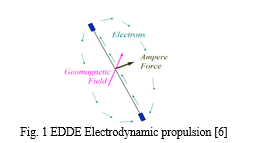
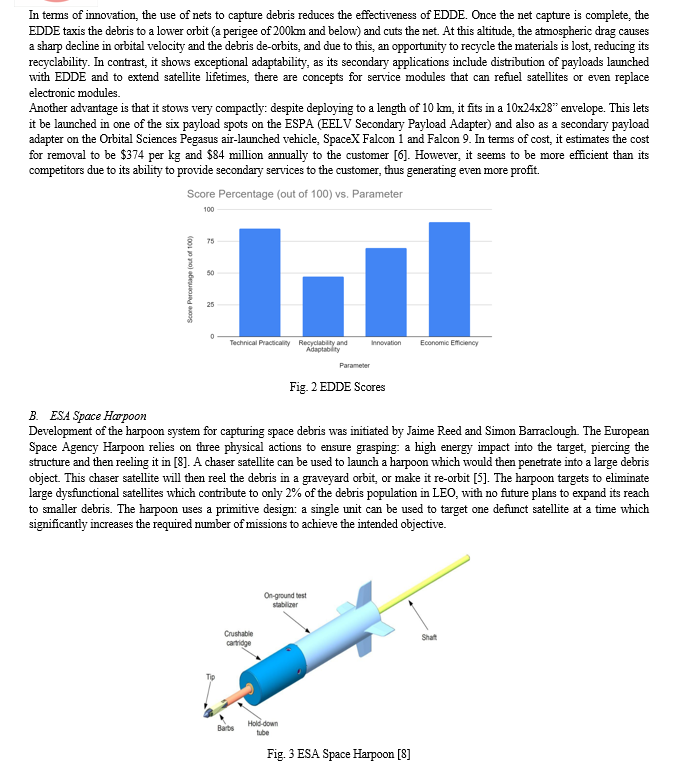
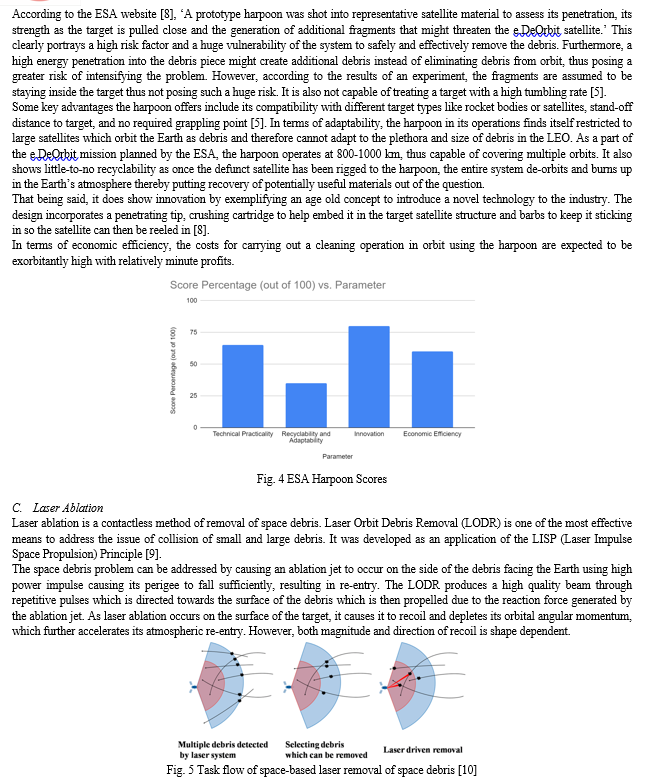
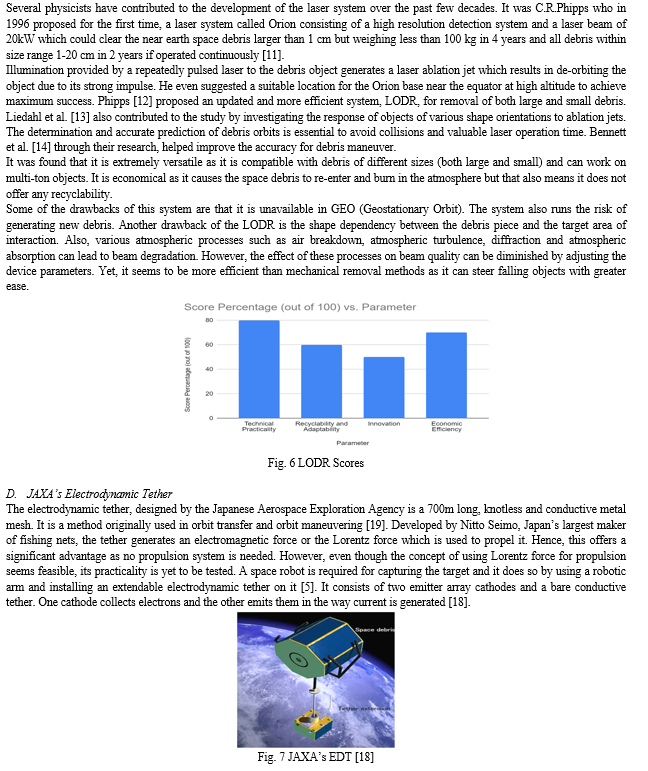
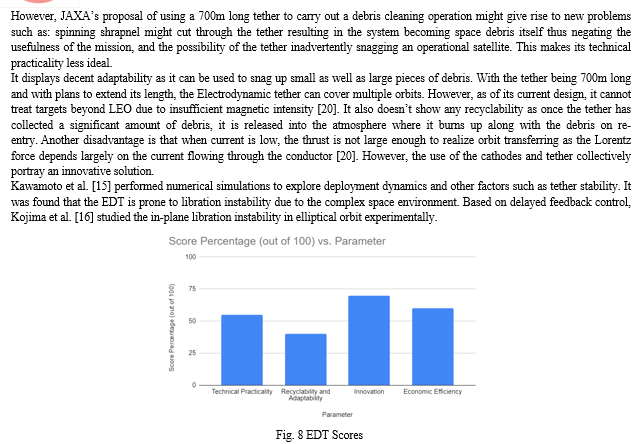
IV. PROPOSED IDEA
A space debris elimination device (which targets <10cm size debris - that contribute to 98% of the debris population in LEO) that works on the basis of location, tracking, collection, elimination of debris from their orbits and recycling of these is proposed. The device would first be launched by a launch vehicle and it would then classify debris according to existing databases and catalogs. Once it identifies its target debris using various sensors such as Hyperspectral Image sensors, LIDAR proximity sensors, radar transmitters and receivers etc., the orbit of the device is aligned with the orbit of the debris using thrust vectoring from Solar Powered Hall Effect thrusters. This orientation can be efficiently achieved through the usage of CMGs (Control Moment Gyroscopes). The concept of Solar Powered Hall Effect Thrusters was first used by the European Space Agency to power its SMART-1 satellite in 2003 [17]. The thrusters operate by their channel or anode being charged to a high positive potential by their power supply (solar energy), while a hollow cathode located on the downstream perimeter of the thruster generates electrons. As the electrons move towards the channel, they encounter a magnetic field generated by the thruster’s powerful electromagnets. This magnetic field traps the electrons, causing them to form a circular ring, known as the Hall current. A propellant (typically Xenon) is injected into the thrusters channel. The thrusters ionize propellant atoms through electron bombardment, where high energy electrons collide with propellant atoms to release a second electron. The propellant ions which have been generated experience the electric field produced by the positive channel, and the negative ring of electrons accelerate out of the thruster, creating an ion beam. The force which the ions impart to the electron cloud generates the thrust required.
The CMG would form the non-propulsive altitude control system for the device which works in correspondence with the Hall Effect thrusters. Using a concept known as momentum management for their functioning, CMGs act as momentum storing devices that exchange momentum with the device through induced torques, the changing angular momentum further causes a gyroscopic torque that rotates the device [21]. This can be used in a cost-effective way to make fine adjustments to the orbital altitude of the device.
A sealed system or airlock incorporated in the device that ‘stores’ the debris at relative rest can be pressurized using compressed N2 gas. Automated flow-control valves can be used to maintain a check on the pressure balance in the device. Solar power used to operate the motors can be connected to a set of fans so as the blades of the fan turn, they create a pressure difference by creating a partial vacuum on one side. The difference in pressure propels the particles of nitrogen gas from the debris containing airlock towards the fan which consequently creates a suction within its pressurized environment. The debris piece can then be pulled further in where another suction pull maneuvers the piece of debris into ‘storage containers’. The walls of the container are coated with a layer of Elastosil, an adhesive which is highly resistant to extreme temperatures. This can make the debris piece stick to the walls of the container, and can thus be transported to any said station for recycling purposes. This can be achieved by constructing an ‘arm’ of the device of sorts that can dock with other stations, which in turn could collect the debris and transfer it back to Earth for recycling.
This device can prove to be relatively energy efficient and offer recyclability to a great extent, while exemplifying innovation. However, this system poses certain limitations. Even though there has been testing of the above mentioned technologies, they have not been used in conjunction yet to corroborate the technical practicality of such a device. Due to highly elliptical orbits and high velocity motion, sudden and sharp fluctuations in the rotation rates of debris particles have been observed. At these rates, the spinning of the debris particles can put the device’s internal components at risk. However, this may be avoided by the usage of Magnetic Damping embedded in the walls of the airlocks. Furthermore, this device can be expected to give rise to high operational costs.
Conclusion
The rise of space debris in the Low Earth Orbit (LEO) is an obstacle to future space missions, necessitating the development of effective mitigation strategies. This research paper assesses various existing solutions including the ElectroDynamic Debris Eliminator (EDDE), ESA’s Space Harpoon, Laser Ablation, and JAXA’s Electrodynamic Tether on the basis of specific parameters. Each of the models are reviewed and their advantages and disadvantages have been discussed. Building on these insights, this paper briefly introduces a novel concept for debris mitigation that aims to target smaller debris by leveraging advanced technologies. Ongoing innovation and teamwork between international space agencies and private companies are essential for tackling the increasing problem of space debris and ensuring the future success of space exploration and use.
References
[1] McCall, P. D., Modeling, simulation, and characterization of space debris in low-Earth orbit, FIU Electronic Theses and Dissertations [Thesis], 2013. https://doi.org/10.25148/etd.FI13120401 [2] Kessler, D.J. and Cour-Palais B.G., Collision Frequency of Artificial Satellites: The Creation of a Debris Belt, Journal of Geophysical Research, Vol. 83, No. A6, pp. 2637-2646, June 1, 1978. [3] Bonnal, C., Ruault, J., & Desjean, M., Active debris removal: Recent progress and current trends, Acta Astronautica, 85, 51–60, 2013. https://doi.org/10.1016/j.actaastro.2012.11.009 [4] Emanuelli, M., Federico, G., Loughman, J., Prasad, D., Chow, T., Rathnasabapathy, M., Conceptualizing an economically, legally, and politically viable active debris removal option, Acta Astronaut. 104 197e205, 2014. https://doi.org/10.1016/j.actaastro.2014.07.035. [5] Shan, M., Guo, J., Gill, E., Review and comparison of active space debris capturing and removal methods, Prog. Aero. Sci. 80 18e32, 2016. https://doi.org/10.1016/j.paerosci.2015.11.001. [6] Pearson, J., Levin, E., Oldson, J., Carroll, J., ElectroDynamic Debris Eliminator (EDDE): design, operation, and ground support. In Advanced Maui Optical and Space Surveillance Technologies Conference, 2010. [7] Carroll, J., Levin, E. M., Pearson, J., Delivery of secondary payloads to custom orbits using EDDE. 65th International Astronautical Congress, Toronto, Canada, 1–13, 2014. [8] Whale of a target: harpooning space debris. (n.d.). https://www.esa.int/Space_Safety/Clean_Space/Whale_of_a_target_harpooning_spae_debris [9] Phipps, C. R., Michaelis, M. M., Albrecht, G., Friedman, H., Gavel, D., George, E. V., Murray, J., Ho, C., Priedhorsky, W., & Reilly, J. P., Clearing near-Earth space debris using a 20-kW, 530-nm, Earth-based, repetitively pulsed laser. In ORION, February 23, 2007 edition. [10] Yang, W., Fu, H., Shao, Z., Wu, Q., & Chen, C. Target selection for a Space-Energy driven Laser-Ablation debris removal system based on Ant colony optimization. Sustainability, 15(13), 10380, 2023. https://doi.org/10.3390/su151310380 [11] Campbell, J. W., Project ORION: Orbital Debris Removal Using Ground-Based Sensors and Lasers, vol. 108522, NASA Marshall Spaceflight Center Technical Memorandum, 1996. [12] Phipps, C. R., A laser-optical system to re-enter or lower low Earth orbit space debris. Acta Astronautica, 93, 418–429, 2014. https://doi.org/10.1016/j.actaastro.2013.07.031 [13] Liedahl, D. A., Rubenchik, A., Libby, S. B., Nikolaev, S., Phipps, C. R., Pulsed laser interactions with space debris: Target shape effects. In Advances in Space Research (Vol. 52, pp. 895–915) [Journal-article], 2013. http://dx.doi.org/10.1016/j.asr.2013.05.019 [14] Bennett, J. C., Sang, J., Smith, C., & Zhang, K., Accurate orbit predictions for debris orbit maneuver using ground-based lasers. Advances in Space Research, 52(11), 1876–1887, 2013. https://doi.org/10.1016/j.asr.2013.08.029 [15] Kawamoto, S., Makida, T., Sasaki, F., Okawa, Y., Nishida, S, Precise numerical simulations of electrodynamic tethers for an active debris removal system. Acta Astronautica, 59(1–5), 139–148, 2006.. https://doi.org/10.1016/j.actaastro.2006.02.035 [16] Kojima, H., Furukawa, Y., & Trivailo, P. M., Experimental study on delayed feedback control for libration of tethered satellite System. Journal of Guidance, Control, and Dynamics, 35(3), 998–1002, 2012. https://doi.org/10.2514/1.57018 [17] SMART-1. (n.d.). https://ww.esa.int/Science_Exploration/Space_Science/SMART-12 [18] Nishida, S., Kawamoto, S., Okawa, Y., Terui, F., Kitamura, S, Space debris removal system using a small satellite. Acta Astronautica, 65(1–2), 95–102, 2009. https://doi.org/10.1016/j.actaastro.2009.01.041 [19] Williams, P, Optimal Orbit Transfer with Electrodynamic Tether. Journal of Guidance, Control, and Dynamics, 28(2), 369–372, 2005.. https://doi.org/10.2514/1.12016 [20] Tragesser, S. G. and San, H. Orbital Maneuvering with Electrodynamic Tethers. Journal of Guidance, Control, and Dynamics, 26(5), 805–810, 2003.. https://doi.org/10.2514/2.5115 [21] Gurrisi, C., Seidel, R., Dickerson, S., Didziulis, S., Frantz, P., Ferguson, K, Space station control moment gyroscope lessons learned. In Proceedings of the 40th Aerospace Mechanisms Symposium, NASA Kennedy Space Center, May 12-14, 2010. [22] Analytical Studies for Photometric and positional observations of space debris. International Journal of Advanced Research, 713–722, 2014. https://www.researchgate.net/publication/272828360 [23] Reed, J., and Barraclough, S., Development of Harpoon System for Capturing Space Debris. In Proc. 6th European Conference on Space Debris, 2013.
Copyright
Copyright © 2024 Ameya Aneja. This is an open access article distributed under the Creative Commons Attribution License, which permits unrestricted use, distribution, and reproduction in any medium, provided the original work is properly cited.

Download Paper
Paper Id : IJRASET63830
Publish Date : 2024-07-31
ISSN : 2321-9653
Publisher Name : IJRASET
DOI Link : Click Here
 Submit Paper Online
Submit Paper Online

